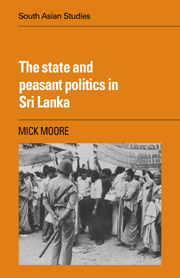Book contents
- Frontmatter
- Contents
- List of maps
- List of tables
- Acknowledgments
- Glossary of Sri Lankan terms
- Maps
- 1 Puzzles and agendas
- 2 Methods, scope and elaborations
- 3 Crown lands
- 4 Land reform
- 5 Pricing and agricultural services
- 6 Categorising space: urban–rural and core–periphery
- 7 A smallholder interest or smallholder interests?
- 8 Rural consciousness
- 9 Ethnic conflict and the politics of the periphery
- 10 The Sri Lankan polity
- 11 Concluding remarks
- Appendix 1 Results of general elections, 1947–77: percentage of parliamentary seats won
- Appendix 2 The myth of the plantation impact on the Sinhalese village: two accounts
- Notes
- Bibliography
- Index
- CAMBRIDGE SOUTH ASIAN STUDIES
6 - Categorising space: urban–rural and core–periphery
Published online by Cambridge University Press: 05 March 2012
- Frontmatter
- Contents
- List of maps
- List of tables
- Acknowledgments
- Glossary of Sri Lankan terms
- Maps
- 1 Puzzles and agendas
- 2 Methods, scope and elaborations
- 3 Crown lands
- 4 Land reform
- 5 Pricing and agricultural services
- 6 Categorising space: urban–rural and core–periphery
- 7 A smallholder interest or smallholder interests?
- 8 Rural consciousness
- 9 Ethnic conflict and the politics of the periphery
- 10 The Sri Lankan polity
- 11 Concluding remarks
- Appendix 1 Results of general elections, 1947–77: percentage of parliamentary seats won
- Appendix 2 The myth of the plantation impact on the Sinhalese village: two accounts
- Notes
- Bibliography
- Index
- CAMBRIDGE SOUTH ASIAN STUDIES
Summary
Introduction
The reasons why Sri Lankan smallholders have failed to articulate certain kinds of class demand are explored in detail in Chapters Seven to Ten. This chapter, dealing with the spatial dimension of the Sri Lankan economy and polity, is an essential preliminary. It justifies the use in later chapters of the core–periphery continuum as an analytical tool.
Because the focus of this book is on rural politics, and because the terms ‘rural’ and ‘urban’ have been freely used in the preceding chapters, the reader has thus far been implicitly encouraged to believe that the rural–urban dividing line is a significant boundary within Sri Lanka: that the terms ‘rural’ and ‘urban’ do indicate significantly different elements or ‘subsystems’ within the national economy or polity. The purposes of this chapter are (a) to expose the falsity of this assumption and (b) to indicate that, in order both to describe the economy of Sri Lanka and to analyse the polity, the concept of a core–periphery continuum based on location is a more useful way to begin to categorise the population than is the acceptance of the notion of any fundamental urban–rural dichotomy in terms of occupation or access to political power. Part of the reason why smallholder class interests have not been articulated is that there is not in Sri Lanka a clear objective basis for a rural–urban conflict of interest over agricultural and food policy.
- Type
- Chapter
- Information
- The State and Peasant Politics in Sri Lanka , pp. 121 - 140Publisher: Cambridge University PressPrint publication year: 1985

